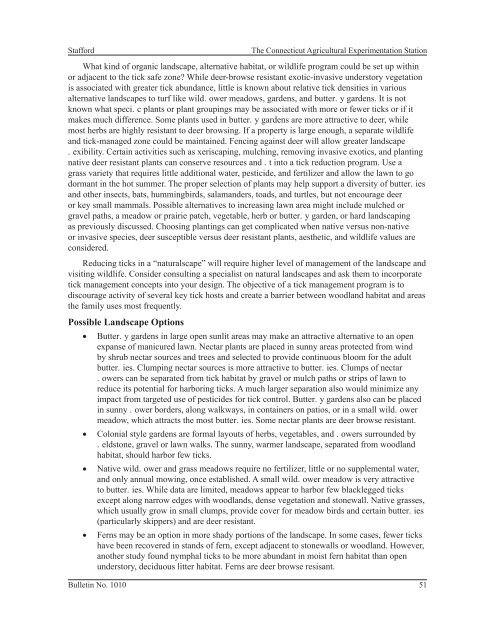Dr. Stafford Tick Management Handbook - Newtown, CT
Dr. Stafford Tick Management Handbook - Newtown, CT
Dr. Stafford Tick Management Handbook - Newtown, CT
You also want an ePaper? Increase the reach of your titles
YUMPU automatically turns print PDFs into web optimized ePapers that Google loves.
<strong>Stafford</strong>The Connecticut Agricultural Experimentation StationWhat kind of organic landscape, alternative habitat, or wildlife program could be set up withinor adjacent to the tick safe zone? While deer-browse resistant exotic-invasive understory vegetationis associated with greater tick abundance, little is known about relative tick densities in variousalternative landscapes to turf like wild. ower meadows, gardens, and butter. y gardens. It is notknown what speci. c plants or plant groupings may be associated with more or fewer ticks or if itmakes much difference. Some plants used in butter. y gardens are more attractive to deer, whilemost herbs are highly resistant to deer browsing. If a property is large enough, a separate wildlifeand tick-managed zone could be maintained. Fencing against deer will allow greater landscape. exibility. Certain activities such as xeriscaping, mulching, removing invasive exotics, and plantingnative deer resistant plants can conserve resources and . t into a tick reduction program. Use agrass variety that requires little additional water, pesticide, and fertilizer and allow the lawn to godormant in the hot summer. The proper selection of plants may help support a diversity of butter. iesand other insects, bats, hummingbirds, salamanders, toads, and turtles, but not encourage deeror key small mammals. Possible alternatives to increasing lawn area might include mulched orgravel paths, a meadow or prairie patch, vegetable, herb or butter. y garden, or hard landscapingas previously discussed. Choosing plantings can get complicated when native versus non-nativeor invasive species, deer susceptible versus deer resistant plants, aesthetic, and wildlife values areconsidered.Reducing ticks in a “naturalscape” will require higher level of management of the landscape andvisiting wildlife. Consider consulting a specialist on natural landscapes and ask them to incorporatetick management concepts into your design. The objective of a tick management program is todiscourage activity of several key tick hosts and create a barrier between woodland habitat and areasthe family uses most frequently.Possible Landscape Options• Butter. y gardens in large open sunlit areas may make an attractive alternative to an openexpanse of manicured lawn. Nectar plants are placed in sunny areas protected from windby shrub nectar sources and trees and selected to provide continuous bloom for the adultbutter. ies. Clumping nectar sources is more attractive to butter. ies. Clumps of nectar. owers can be separated from tick habitat by gravel or mulch paths or strips of lawn toreduce its potential for harboring ticks. A much larger separation also would minimize anyimpact from targeted use of pesticides for tick control. Butter. y gardens also can be placedin sunny . ower borders, along walkways, in containers on patios, or in a small wild. owermeadow, which attracts the most butter. ies. Some nectar plants are deer browse resistant.• Colonial style gardens are formal layouts of herbs, vegetables, and . owers surrounded by. eldstone, gravel or lawn walks. The sunny, warmer landscape, separated from woodlandhabitat, should harbor few ticks.• Native wild. ower and grass meadows require no fertilizer, little or no supplemental water,and only annual mowing, once established. A small wild. ower meadow is very attractiveto butter. ies. While data are limited, meadows appear to harbor few blacklegged ticksexcept along narrow edges with woodlands, dense vegetation and stonewall. Native grasses,which usually grow in small clumps, provide cover for meadow birds and certain butter. ies(particularly skippers) and are deer resistant.• Ferns may be an option in more shady portions of the landscape. In some cases, fewer tickshave been recovered in stands of fern, except adjacent to stonewalls or woodland. However,another study found nymphal ticks to be more abundant in moist fern habitat than openunderstory, deciduous litter habitat. Ferns are deer browse resisant.Bulletin No. 1010 51











